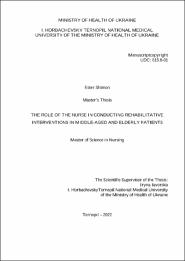Показати скорочений опис матеріалу
THE ROLE OF THE NURSE IN CONDUCTING REHABILITATIVE INTERVENTIONS IN MIDDLE-AGED AND ELDERLY PATIENTS
| dc.contributor.author | Shimon, Ester | |
| dc.date.accessioned | 2022-09-05T14:12:35Z | |
| dc.date.available | 2022-09-05T14:12:35Z | |
| dc.date.issued | 2022 | |
| dc.identifier.citation | Shimon, Ester. (2022) THE ROLE OF THE NURSE IN CONDUCTING REHABILITATIVE INTERVENTIONS IN MIDDLE-AGED AND ELDERLY PATIENTS. I. HORBACHEVSKY TERNOPIL NATIONAL MEDICAL UNIVERSITY OF THE MINISTRY OF HEALTH OF UKRAINE, Ternopil. 66 р. | uk |
| dc.identifier.uri | https://repository.tdmu.edu.ua//handle/123456789/17543 | |
| dc.description.abstract | Rehabilitation is an integral part of general health services coverage along with health promotion, prevention of disease, treatment and palliative care. This research project about the process of rehabilitation and how it helps children, young patients, adults and the elderly to be as autonomous as possible in their daily lives and allows them to get their education, to work and engage in leisure activities, as well as to perform important functions such as caring for their family. The data for this project were collected via examination of patients (subjective and objective methods): collection of health history and history of present disease, physical examination (inspection, percussion, palpation and auscultation); laboratory and imaging tests, including endoscopic, radiological and ultrasound diagnostics; the statistical method, data analysis, and inferencing. As a result of this research study, we have reviewed the basic principles of rehabilitative interventions; defined the importance of physical and psychological rehabilitation and studied the mechanisms behind health-promoting effects of rehabilitative interventions; studied the specific features of rehabilitation in elderly patients with musculoskeletal damage; studied the specific features of rehabilitation in cardiovascular disease; defined the basic principles of rehabilitation of patients with certain types of injuries, such as thoracic trauma, abdominal trauma, and patients after surgical interventions on urinary system; and defined the basic principles for rehabilitation of patients with spinal fractures and patients with nervous system diseases. These findings indicate that people with limited mobility constitute the main part of such patient population; they have more pronounced activity and self-care deficits and as such require physical assistance and prolonged medico-social rehabilitation. Among neurological disorders, the most widely spread entities include cerebrovascular accidents, neurological manifestations of degenerative disc disease and cerebral and spinal injuries. | uk |
| dc.language.iso | en | uk |
| dc.publisher | Ternopil | uk |
| dc.subject | REHABILITATIVE INTERVENTIONS | uk |
| dc.subject | PHYSICAL REHABILITATION | uk |
| dc.subject | PSYCHOLOGICAL REHABILITATION | uk |
| dc.subject | HEALTH-IMPROVING EFFECT | uk |
| dc.subject | REHABILITATION | uk |
| dc.subject | MUSCULOSKELETAL DAMAGE | uk |
| dc.subject | CARDIOVASCULAR DISEASE | uk |
| dc.subject | THORACIC TRAUM | uk |
| dc.subject | ABDOMINAL TRAUMA | uk |
| dc.subject | SPINAL FRACTURES | uk |
| dc.subject | PATIENTS WITH SPINAL FRACTURES | uk |
| dc.subject | NERVOUS SYSTEM DISEASES | uk |
| dc.subject | SURGICAL INTERVENTIONS ON URINARY SYSTEM | uk |
| dc.subject | ELDERLY | uk |
| dc.title | THE ROLE OF THE NURSE IN CONDUCTING REHABILITATIVE INTERVENTIONS IN MIDDLE-AGED AND ELDERLY PATIENTS | uk |
| dc.title.alternative | Master's Thesis | uk |
| dc.type | Thesis | uk |

